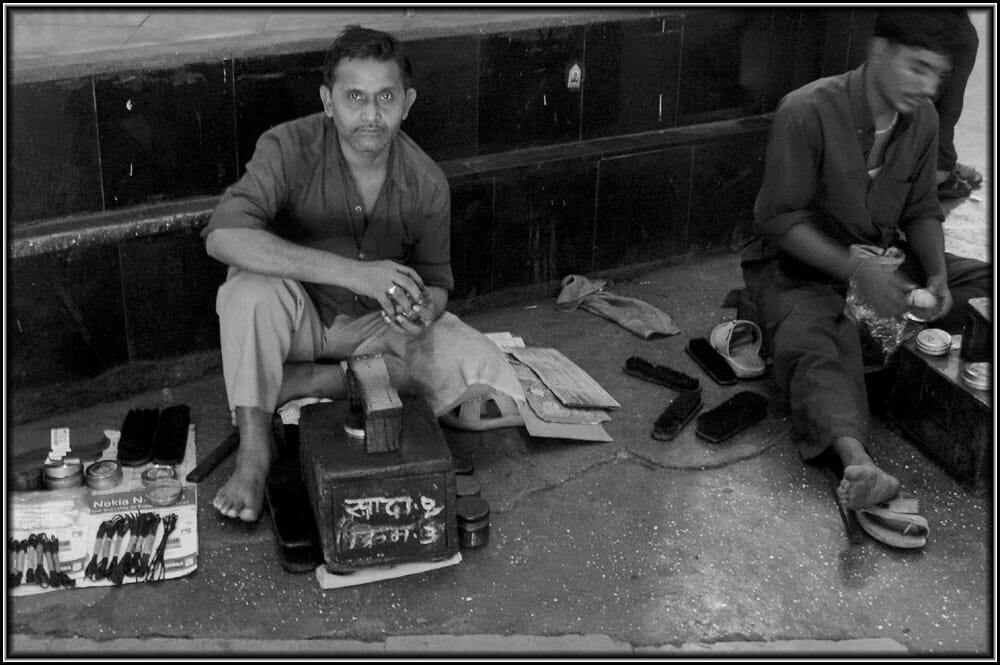On a sunny Saturday morning, Jai* hoists his shoe onto the platform of one of the many shoeshine workers on Borivali station. The job barely takes minutes. As per usual rates, he pays Rs 10 for his newly cream-polished shoes. But as he turns to leave, he’s called back: he owes Vinod, the shoeshiner, an additional Rs 5. The cost of shoeshining has increased.
The writing on Vinod’s wooden stand is clear: Sada (plain/ordinary) – Rs 10, Cream – Rs 15. Jai’s surprise is not unfounded. The last time shoeshine rates on the stations increased – to Rs 7 for a sada (plain) finish, and Rs 10 for cream – was in 2015.
“Many years ago, it used to be Rs 0.75 for plain and Rs 1 for cream,” says Ramji Ram, another shoeshine worker on the first platform at Andheri station. “Then it increased to Rs 1 and Rs 2, Rs 4 and Rs 5, Rs 5 and Rs 7, and so on.” The current increase comes, after all this time, on the approval of the senior divisional commercial manager (DCM) of the railways.

“We demanded this a while ago,” says a member of the Bombay Harijan Cooperative Society, to which Ramji and all the shoeshiners at Andheri station belong. Every shoeshine worker is a member of a cooperative society. Ramji’s society is not the only one to ask for an increase, corroborates the public relations officer of the Western Railway (WR), Sumit Thakur. After all, the root of the demand is mehangai, or, the overall increase in “the price index in the country,” says Sumit.
“It’s taken a long time to increase,” acknowledges Ramji, speaking matter-of-factly. “But it’s not in our hands, is it?”

The mechanics of the profession
Shoe shining is one stream of revenue for the railways, hence it falls under the commercial department. The railways are essentially renters of the prized 1 square foot space (no such thing as too small in Mumbai).
“The cooperative society is a mediator between the railways and shoeshine workers,” says Sumit.
Every three years, they invite tenders for shoe shining spots on stations. Each spot comes with a licence fee, and the price of shoeshining. It’s an earning contract, says the PRO. The workers in turn pay the cooperative society Rs 30 every day, adding to a fee of Rs 900 per month. The society pays a licence fee of Rs 487 per worker in a month (from April), equal to around half the fee they charge the workers.
The remaining amount is used for the other responsibilities of the society, says Sonu Kumar, a shoeshine worker on CSMT station and secretary of the M/S Bombay Shoeshine Cooperative Society. “We collect the licence fee from the workers, pay the railway, buy the blue shirt and pant uniform, and letterheads,” he says.
This leaves the workers in a strange spot: neither are they employees, nor are they the deciders of the rates of the service they offer.

Read more: On BMC’s ‘eligible’ list, why are hawkers in Mumbai still evicted?
Leaving CR behind
This precarious arrangement is also why shoeshining on the parallel Central Railway (CR) is still priced at the old rates: Rs 7 for sada, and Rs 10 for cream.
The CR introduced the price hike earlier in February through an open tender. But it came with a caveat. The tenders would be open to the highest bidder, instead of sticking to the societies already in place, most of which are long established ones. The Sharmik Boot Polish Producers Co-op Society, for instance, has been present since 1958, two years before the job was formally introduced to railways stations by railway minister Jagjivan Ram, as this report states.
The new conditions threatened the present hold of the co-op societies on the stations under their wing over many decades. Workers, in turn, felt their positions could be in danger, and they might be asked to pay many times the daily fee they pay.
“They felt that because this would open up the opportunity to others, they could be removed from their post. They had a certain kind of insecurity,” says B Arunkumar, senior divisional commercial manager (DCM) of the CR.
The shoeshine workers reacted with protests, stopping the new tenders in their tracks.
However, now that the rate has increased on the WR, it is expected to do so on the CR soon too. “We will be writing a letter to the railways requesting them to increase our rate to match the WR,” says Sonu. “But after that, it depends on the railways.”
Failed attempts
A near copy of the events took place back in 2007, when the attempt to privatise similarly gave way to protests and hunger strikes. The workers, along with notable politicians, negotiated to keep their place, and agreed to paying a licence fee with a six per cent hike each year.
This time, however, an extra legal case in the Bombay High Court has impeded the tenders. In the 1999 shoeshine policy, members of scheduled castes or tribes were prioritised. But this was also changed, and is currently being fought in court.
*name changed on request